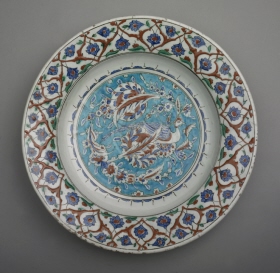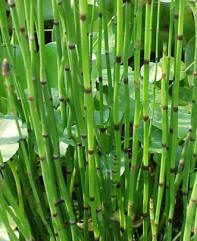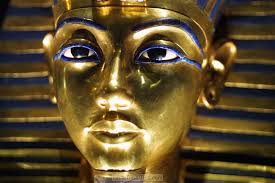 No, me either, but I came across the term when I was looking up ‘gesso’, which is (among other things) the adhesive gunge on to which gold leaf is laid in illuminated manuscripts. The recipe for this type of gesso (Italian ‘chalk’, Greek γύψος) consists of ‘plaster, white lead, sugar and glue, and sometimes Armenian bole, which gives it a pink colour’. (You can see a video of the gilding process here.) It is also used as the base for the gilt edges of books (these days, mostly bibles), which explains why you can sometime see a very, very thin line of red around the pages of gilt-edged books.
No, me either, but I came across the term when I was looking up ‘gesso’, which is (among other things) the adhesive gunge on to which gold leaf is laid in illuminated manuscripts. The recipe for this type of gesso (Italian ‘chalk’, Greek γύψος) consists of ‘plaster, white lead, sugar and glue, and sometimes Armenian bole, which gives it a pink colour’. (You can see a video of the gilding process here.) It is also used as the base for the gilt edges of books (these days, mostly bibles), which explains why you can sometime see a very, very thin line of red around the pages of gilt-edged books.

Applying pink gesso to the edges of the book block before gilding.

Rabbits conduct a funeral, processing along a golden path, from the Macclesfield Psalter. (Credit: the Fitzwilliam Museum)
But my question is: who worked out that this unlikely combination of things would work, and how was it discovered that Armenian bole (an earthy clay, red due to the presence of iron oxide, mostly found in Armenia) would be a good extra ingredient? Chambers’ 1728 Cyclopaedia, or An Universal Dictionary of Arts and Sciences, describes it in medicinal terms: ‘a good Astringent and Vulnerary; and in those Intentions frequently prescribed against Diarrhaeas, Dyssenteries, Haemorrhages, and other Defluxions. Externally it is used in strengthening Plaisters, against Luxations of the Joints.’
Chambers cross-refers it to ‘Bole-Armoniac’, ‘a kind of earth, of considerable Medicinal Virtue, brought from Armenia. The physicians sometimes call it Rubrica synoptica, from the City of Synope, where it is suppos’d to be found. ‘Tis of a pale red Colour, and partakes much of the Nature of Stone; but soft, far [?], friable, easily pulveriz’d, and sticks to the Tongue. ‘Tis esteem’d Desiccative and Stiptic; in which Quality ‘tis us’d in several Diseases, both internal and external. This Bole is easily falsify’d; and the Merchants frequently sell Lemnian-Earth in lieu thereof.’ (It is also used to provide the red colour in Iznik ceramics.)

An Iznik plate from the Wallace Collection: the red colour comes from Armenian bole.
Other ingredients used in recipes for paint include egg yolks (in tempera), sometimes also mixed with powdered myrrh for paintings in churches, to mask the smell of the maturing egg. (And what about myrrh? Who first discovered that the resin of Commiphora myrrha would release perfume when burnt (or indeed ground and mixed into wine)?) Who first realised that the stems of horsetail (Equisetum hyemale), when boiled and dried, provided a form of sandpaper for smoothing gesso applied to wooden surfaces to be painted?

Horsetails: on the face of it, unlikely sandpaper.
Who first tried painting on woven material – linen, canvas – and realised that an under-layer would be a good idea, to smooth the surface and make it less absorbent to the valuable coloured paints?
Lapis lazuli has been mined in Afghanistan since the seventh millennium BCE, and in ancient times was used as a gemstone, most famously perhaps in the headdress, eyes and brows of the mask of Tutankhamun.

The mask of Tutankhamun, inlaid with lapis lazuli.
Rare and costly, the pigment derived from it – ultramarine, so called because it came from across the sea (though I also like the idea that it is ‘beyond sea-blue’) – was famously used in medieval and Renaissance painting for the robes of the Virgin Mary.

Van Eyck’s ‘Annunciation’, in the National Gallery of Art, Washington, D.C. Lapis lazuli is used for the Virgin’s robe and details of the sumptuous clothing and wings of the angel.
But who worked out the best way to use it? The elaborate instructions below come from the ‘libro dell’arte’ written by Cennino Cennini, a minor Italian artist, in 1437, and published in English translation in 1844 by Mary Philadelphia Merrifield (1804–99) of Brighton, whose interests encompassed fashion, artists’ techniques and pigments, and seaweeds.


How long a period of trial and error (and possible waste of the precious material) eventually resulted in this recipe?
Cennini’s work is a fascinating read, describing both techniques of drawing and painting (in water colour, egg tempera and oil) and the making of the necessary materials, from techniques of colouring (or, indeed, making transparent) paper, to grinding and mixing pigments and making your own brushes. (To preserve the tail of a miniver (= ermine, = stoat), which you have acquired for future use as brush hairs, coat it in clay to keep the moths out.)

This miniver was rescued from the roadside and placed on a hot water bottle in an animal sanctuary in Scotland. One can see why the tail hairs were formerly prized for brushes.
He also discusses the use of water to deepen the black colour in charcoal drawings, something which had baffled me when it appeared in the captions for the superb ‘Titian to Canaletto’ exhibition at the Ashmolean which we went to last week.
But never mind painting: who first used beaten egg-whites to refine and clarify wine or broth? Did it start as a cooking experiment/disaster out of which a potential advantage was realised? More fundamentally, who first realised that the food value of wild grass seeds lay in the stuff inside the hard husk, decided to grind it out, and then cooked it?

Goat-grass (Aegilops), the earliest cultivated grain plant.
Who first noticed that seeds lead to new plants, and decided to gather them before they fell, and plant them in rows? How on earth did anyone realise that if you heated some kinds of rock, they appeared to turn liquid and them harden again, and that you could control this process and shape the liquid into something useful?

A Chalcolithic axe-head.
Let alone that a mix of two different metals produced a better result?

A Bronze-Age dagger.
I remember a reading book at my primary school, in which a naughty, rebellious Palaeolithic child didn’t like raw meat, and, when forced to eat it, had a tantrum and threw her portion into the fire, from which such delicious aromas arose that cooking became the new trendy Palaeolithic thing.
I’m not drawing any profound conclusions from this ramble, except that the world is full of the most startling, amazing and thought-provoking facts – for more on painting materials, consider orpiment, or ground chicken bones (see Cennini for both of these) – which is something I knew already, but in which I continue to delight.
Caroline

Pingback: Halcyon Days | Professor Hedgehog's Journal
Pingback: Object of the Month: January | Professor Hedgehog's Journal
Pingback: Bemerton | Professor Hedgehog's Journal
Pingback: Plant of the Month: July | Professor Hedgehog's Journal
Pingback: Object of the Month: January 2017 | Professor Hedgehog's Journal
Pingback: Joseph Was An Old Man | Professor Hedgehog's Journal
Pingback: Epiphanius Evesham | Professor Hedgehog's Journal
Pingback: The Bluetit | Professor Hedgehog's Journal
Pingback: Art and Algology | Professor Hedgehog's Journal